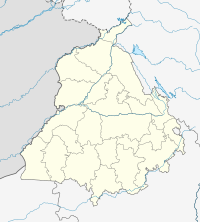Golden Temple
| Harmandir Sahib Golden Temple ਸ੍ਰੀ ਹਰਿਮੰਦਰ ਸਾਹਿਬ | |
|---|---|

The Harmandir Sahib (Golden Temple)
| |
| Alternative names | Sri Darbar Sahib Golden Temple of Amritsar(Harminder Sahib) |
| General information | |
| Town or city | Amritsar |
| Coordinates | 31°37′12″N 74°52′37″ECoordinates: 31°37′12″N 74°52′37″E |
| Construction started | December 1581[1] |
| Completed | 1589 (Temple), 1604 (with Adi Granth) [1] |
| Website | |
| Shiromani Gurdwara Parbandhak Committee Official Website | |
The Golden Temple, also known as Darbar Sahib (Punjabi pronunciation: [dəɾbɑɾ sɑhɪb] or Sri Harmandir Sahib ("Abode of God"), "Exalted Holy Court"), is a Gurdwara located in the city of Amritsar, Punjab, India.[2][3] It is the holiest Gurdwara and the most important pilgrimage site of Sikhism.[2][4]
The temple is built around a man-made pool (Sarovar) that was completed by Guru Ram Das in 1577.[5][6] Guru Arjan, the fifth Guru of Sikhism, requested Sai Mian Mir - a Muslim Pir of Lahore, to lay its foundation stone in 1589.[1] In 1604, Guru Arjan placed a copy of the Adi Granth in Harmandir Sahib, calling the site Ath Sath Tirath (lit. "shrine of 68 pilgrimages").[2][7] The temple was repeatedly rebuilt by the Sikhs after it became a target of persecution and was destroyed several times by the Muslim armies from Afghanistan and the Mughal Empire.[4][8] The army led by Ahmad Shah Abdali, for example, demolished it in 1757 and again in 1762, then filled the pool with garbage.[2]The construction work of the present day Harmandir Sahib took place in 1764 under the leadership of Sultan Al Quam Sardar Jassa Singh 1718-1783 and other leading Sikh Misl Sardars and Jagirdars under Kaar Seva, large Sikh congregations assembled at Amritsar to help rebuild Darbar Sahib. Harmandir Sahib was finally completed in 1776. [9] Maharaja Ranjit Singh visited Darbar Sahib in 1802 after seizing Amritsar from Sardar Gurdit Singh Dhillon and his Mother Mai Sukkha of Bhangi Sikh Misl. Maharaja laid it in marble and copper in from between 1820-1831. overlaid the sanctum with gold foil by 1830. This has led to the name the Golden Temple.[10][11][12]
The temple is spiritually the most significant shrine in Sikh Religion. In the early 1980s, the temple became a center of conflict between the Indian government led by Indira Gandhi, some Sikh groups and a militant movement led by Jarnail Singh Bhindranwale seeking to create a new nation named Khalistan. In 1984, Gandhi sent in the Indian Army as part of Operation Blue Star, leading to deaths of over 1,000 militants, soldiers and civilians, as well as causing much damage to the temple and the destruction of Akal Takht. The temple complex was rebuilt again after the 1984 damage.[4][13]
The Harmandir Sahib is an open boat of worship for all men and women, from all walks of life and faith.[2] It has a square plan with four entrances, has a circumambulation path around the pool. The temple is a collection of buildings around the sanctum and the pool.[2] One of these is Akal Takht, the chief center of religious authority of Sikhism.[4] Additional buildings include a clock tower, the offices of Gurdwara Committee, a Museum and a langar – a free Sikh community run kitchen that serves a simple vegetarian meal to all visitors without discrimination.[4] Over 100,000 people visit the holy shrine daily for worship.[14] The temple complex has been nominated as a UNESCO World Heritage Site, and its application is pending on the tentative list of UNESCO.[15]
Contents
Nomenclature[edit]
The Harmandir Sahib is also spelled as Harimandar, Harimandir or Harmandar Sahib.[2] It is also called the Darbar Sahib (Punjabi pronunciation: [dəɾbɑɾ sɑhɪb]) which means "sacred audience", as well as the Golden Temple for its gold foil covered sanctum center.[4] The word "Harmandir" is composed of two words, "Hari" which scholars variously translate either as "God" or akal purakh[2] and "mandir" which means temple or house.[16] The Sikh tradition has several Gurdwaras named "Harmandir Sahib" such as those in Kiratpur and Patna. Of these, the one in Amritsar is most revered.


Comments
Post a Comment